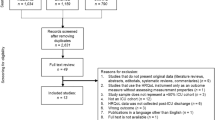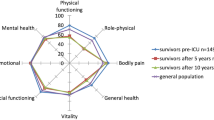Abstract
Objective
To compare two health-related quality of life measures, the preference-based EQ-5D with five questions and the profile-based RAND-36 with 36 questions, in previous critically ill patients.
Design
Prospective observational study.
Setting
A ten-bed medical-surgical intensive care unit (ICU) in a tertiary care university hospital.
Patients
Of the 2,709 critically ill patients, treated during the years 1995–2000, the 1,099 patients of the 1,443 still alive who returned both mailed measures were included in the study.
Interventions
None.
Measurements and main results
The EQ-5D and the RAND-36 correlated well (P <.001). Ceiling effect was more obvious with the EQ-5D; the values of the RAND-36 varied usually from 0 to 100 in all the three levels of the corresponding EQ-5D question, and the weakest statistically significant differences were between the EQ levels 2 and 3. In particular, the RAND-36 proved to differentiate better the levels of mobility, self-care, and poor outcome.
Conclusions
The EQ-5D and the RAND-36 correlated well, but when more precisely stated information is needed, especially regarding mobility, self-care, or low quality of life levels of previous critically ill patients, the profile-based RAND-36 may discriminate better.

Similar content being viewed by others
References
Angus DC, Carlet J (2003) Surviving intensive care: a report from the 2002 Brussels Roundtable. Intensive Care Med 29:368–377
Black NA, Jenkinson C, Hayes JA, Young D, Vella K, Rowan KW, Daly K, Ridley S (2001) Review of outcome measures used in adult critical care. Crit Care Med 29:2119–2124
Bowling A (1997) Evaluating health services: multidisciplinary collaboration. In: Research methods in health care. Open University, Buckingham Philadelphia, pp 6–15
Garrett A, Schmidt L, Macintosh A, Fitzpatric R (2002) Quality of life measurement: bibliographic study of patients assessed health outcome measure. BMJ 324:1417
Jones I (1997) Costing health services: health economics. In: Bowling A (ed) Research methods in health care. Open University, Buckingham Philadelphia, pp 79–97
Kutsogiannis DJ, Noseworthy T (2001) Health-related quality of life; during and following critical care. In: Sibbald JW, Bion JF (eds) Evaluating critical care. Springer, Berlin Heidelberg New York, pp 86–103
Kerridge RK, Glasziou PP, Hillman KM (1995) The use of “quality-adjusted life years” (QALYs) to evaluate treatment in intensive care. Anaesth Intens Care 23:322–331
Heyland DK, Guyatt G, Cook DJ, Meade M, Juniper E, Cronin L, Gafni A (1998) Frequency and methodological rigor of quality of life assessments in the critical care literature. Crit Care Med 26:591–598
Patrick DL, Danis M, Southerland LI, Hong G (1988) Quality of life following intensive care. J Gen Intern Med 3:218–223
Bergner M, Robbitt RA, Kressel S, Pollard WE, Gibson BS, Morris JR (1981) The sickness impact profile. Development and final version of health status measure. Med Care 19:787–805
Hunt SM, McKenna SP, McEwen J, Williams J, Papp E (1981) The Nottingham health profile: subjective health status and medical consultations. Soc Sci Med 15:221–229
Ware MK, Snow KK, Kosinski M, Gandek B (1993) SF-36 Health survey: manual and interpretation guide. The Health Institute, New England Medical Centre, Boston
Kind P, Rosser RM, Williams A (1982) Valuation of quality of life; some psychometric evidence. In: Jones-Lee MW (ed) The value of life and safety. Elsevier, Amsterdam
Spitzer WO, Dobson AJ, Hall J, Chesterman E, Levi J, Shepherd R, Battista RN, Catchlove BR (1981) Measuring the quality of life of cancer patients: a concise Quality of Life Index for use by physicians. J Chronic Dis 34:585–597
Hays RD, Sherbourne CD, Mazel R (1993) The RAND 36-item HEALTH survey 1.0. Health Econ 2:217–277
Brooks R (1996) EuroQol; the current state of Play. Health Policy 37:53–72
Bowling A (1997) The principles of research. In: Research methods in health care. Open University, Buckingham Philadelphia, pp 130–138
Johnson JA, Ohinmaa A, Murti B, Sintonen H, Coons SJ (2000) Comparison of Finnish and U.S-based Visual Analog Scale Valuations of the EQ-5D measure. Med Decis Making 20:281–289
Ohinmaa A, Sintonen H (1996) Quality of life of Finnish population measures by EuroQol. In: Badia X, Herdman M, Segura A (eds) EuroQol, Plenary Meeting. Barcelona 1995, 3–5 October. Discussion papers, Catalan Institute of Public Health, Barcelona, pp 161–172
Aalto A, Aro S, Aro AR, Mähönen M (1999) RAND 36-item Survey 1.0. Finnish version. STAKES (National Research and Development Centre for Welfare and Health), Helsinki
Coons SJ, Rao S, Keininger DL, Hays RD (2000) A comparative review of generic quality-of-life instruments. Pharmacoeconomics 17:13–35
Ware JE, Kosinski M, Keller SD (1994) SF-36 Physical and mental health summary scales. A user’s manual. Health Assessment Lab, Boston MA
Knaus WA, Wagner DP, Draper EA, Zimmerman JE (1985) APACHE II severity of disease classification system. Crit Care Med 13:818–829
Myers C, Wilks D (1999) Comparison of Euroqol EQ-5D and SF-36 in patients with chronic fatigue syndrome. Qual Life Res 8:9–16
Brazier J, Jones N, Kind P (1993) Testing the validity of the Euroqol and comparing it with the SF-36 health survey questionnaire. Qual Life Res 2:169–180
Bosch JL, Hunink MG (2000) Comparison of the Health Utilities index Mark 3 (HUI3) and the EuroQol EQ-5D in patients treated for intermittent claudication. Qual Life Res 9:591–601
McHorney CA, Taylor AR (1995) Individual patient monitoring in clinical practice: are available health status surveys adequate? Qual Life Res 4:293–307
Badia X, Diaz-Prieto A, Gorriz MT, Herdman R, Torrado H, Farrero E, Cavanilles JM (2001) Using EuroQol-5D to measure changes in quality of life 12 months after discharge from an intensive care unit. Intensive Care Med 27:1901–1907
Jenkinson C, Stradling J, Petersen S (1998) How should we evaluate health status? A comparison of three methods in patients presenting with obstructive sleep apnea. Qual Life Res 7:95–100
Johnson JA, Coons SJ (1998) Comparison of the EQ-5D and SF-12 in adult US sample. Qual Life Res 7:155–166
Granja C, Teixeira-Pinto A, Costa-Pereira A (2002) Quality of life after intensive care - evaluation with EQ-5D questionnaire. Intensive Care Med 28:898–907
Kaarlola A, Pettilä V, Kekki P (2003) Quality of life six years after intensive care. Intensive Care Med 29:1294–1299
Bosch JL, van der Graaf J, Hunink MGM (1999) Health-related quality of life after angioplasty and stent placement in patients with iliac artery disease; results of the randomised controlled clinical trial. Circulation 99:3155–3160
Herridge MS, Cheung AM, Tansey CM, Matte-Martyn A, Diaz-Granados N, Al-Saidi F, Cooper AB, Guest CB, Mazer CD, Mehta S, Stewart TE, Barr A, Cook D, Slutsky AS (2003) One-year outcome in survivors of the acute respiratory distress syndrome. N Engl J Med 348:683–693
Schelling G, Richter M, Roozendaal B, Rothenhäusler HB, Krauseneck T, Stoll C, Nollert G, Schmidt M, Kapfhammer HP (2003) Exposure to high stress in the intensive care unit may have negative effects on health-related quality-of-life outcome after cardiac surgery. Crit Care Med 31:1971–1980
Cornock MA (1998) Stress and the intensive care patient: perceptions of patients and nurses. J Adv Nurs 27:518–527
Scragg P, Jones A, Fauvel N (2001) Psychological problems following ICU treatment. Anaesthesia 56:9–14
Schelling G, Stoll C, Haller M, Briegel J, Manert W, Hummel T, Lenhart A, Heyduck M, Polasek J, Meier M, Preuss U, Bullinger M, Schuffel W, Peter K (1998) Health-related quality of life and posttraumatic stress disorder in survivors of the acute respiratory distress syndrome. Crit Care Med 26:651–659
Skogstad W (2000) Working in the world of bodies. A medical ward. In: Hinshelwood RD, Skogstad W (eds) Observing organisations. Anxiety, defence and culture in health care. Routledge, London, pp 101–121
Bion WR (1961) Experiences in groups. Routledge, Bristol, pp 59–75
Acknowledgement
We are very thankful to S. Sarna for statistical advice
Author information
Authors and Affiliations
Corresponding author
Electronic Supplementary Material
Appendices
Appendix 1
The EQ-5D questionnaire: http://www.euroqol.org
Appendix 2
The RAND-36 questionnaire: http://www.rand.org/health/surveys/sf36item/questionnaire.html
Rights and permissions
About this article
Cite this article
Kaarlola, A., Pettilä, V. & Kekki, P. Performance of two measures of general health-related quality of life, the EQ-5D and the RAND-36 among critically ill patients. Intensive Care Med 30, 2245–2252 (2004). https://doi.org/10.1007/s00134-004-2471-6
Received:
Accepted:
Published:
Issue Date:
DOI: https://doi.org/10.1007/s00134-004-2471-6




